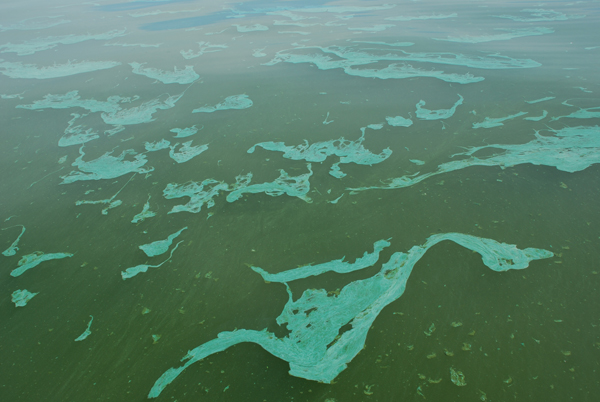 Harmful algal blooms are large accumulations of algal biomass, often occurring or noticeable at the surface of lakes and oceans. They are primarily a nuisance due to odors and hypoxic conditions produced by their decaying biomass. Some, but not all algae produce toxins harmful to humans, pets, and wildlife. In temperate lakes of North America, harmful algal blooms, particularly toxic blooms, are most often caused by one or more species of cyanobacteria (a.k.a. blue-green algae). These photosynthetic bacteria grow during the warmest times of the year and produce both blue (phycocyanin) and green (chlorophyll) pigments giving them a characteristic bright blue appearance. Cyanobacterial blooms are patchy in nature and can form over the course of days or on hourly time scales simply by accumulating at the surface. For this reason, it is extremely difficult to predict when and where cyanobacterial blooms, or more importantly, their toxins will occur.
Harmful algal blooms are large accumulations of algal biomass, often occurring or noticeable at the surface of lakes and oceans. They are primarily a nuisance due to odors and hypoxic conditions produced by their decaying biomass. Some, but not all algae produce toxins harmful to humans, pets, and wildlife. In temperate lakes of North America, harmful algal blooms, particularly toxic blooms, are most often caused by one or more species of cyanobacteria (a.k.a. blue-green algae). These photosynthetic bacteria grow during the warmest times of the year and produce both blue (phycocyanin) and green (chlorophyll) pigments giving them a characteristic bright blue appearance. Cyanobacterial blooms are patchy in nature and can form over the course of days or on hourly time scales simply by accumulating at the surface. For this reason, it is extremely difficult to predict when and where cyanobacterial blooms, or more importantly, their toxins will occur.
We are investigating harmful algal blooms in eutrophic north temperate lakes. The objectives of this work are to 1) identify environmental forces that influence cyanobacterial species composition, 2) characterize controls on spatial and temporal distribution of toxins, particularly at beach and/or swimming locations, 3) develop predictive models of toxin production and fate, 4) improve the use of automated sensors for bloom detection, 5) investigate mitigation strategies for toxic blooms at swimming locations.
Some relevant publications are below. Follow the publications link above for more.
Todd R. Miller, Lucas Beversdorf, Chelsea A. Weirich, and Sarah Bartlett, 2017. Cyanobacterial Toxins of the Laurentian Great Lakes, their Toxicological Effects, and Numerical Limits in Drinking Water. Marine Drugs. 15(6)
Beversdorf, L. J.; Weirich, C. A.; Bartlett, S. L.; Miller, T. R. (2017) Variable cyanobacterial toxin and metabolite profiles across six eutrophic lakes of differing physiochemical characteristics. Toxins 9(2).
Weirich, C.A. and Miller, T.R. 2013. Freshwater algal toxins and children’s health: a review. Current Problems in Pediatrics and Adolescent Health Care. 44:2-24.